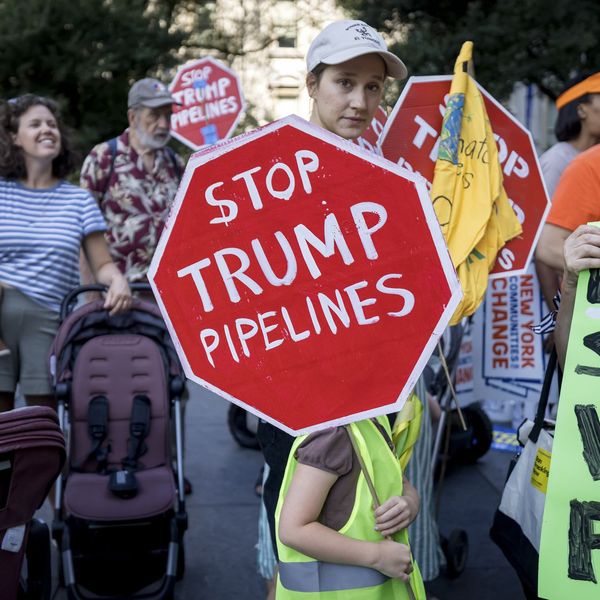Nine States Join Lawsuit Against EPA Carbon Rules
Lawsuit initiated by coal executive and climate change denier
Nine states have joined a lawsuit against the Environmental Protection Agency (EPA) that was initiated by the Murray Energy Corporation, the largest independent coal company in the U.S. The suit aims to strike down the EPA's new rules to regulate carbon emissions from existing power plants, stating that the agency does not have the authority to enforce them.
Murray Energy Corp. is headed by Robert Murray, a climate change denier who has previously sued the EPA over what he calls a "war on coal" that is costing the industry in job losses.
Alaska, Wyoming, Alabama, Ohio, North Carolina, Nebraska, West Virginia, Kentucky, and Oklahoma have all joined the lawsuit that describes the proposed regulations, which seek to cut carbon emissions from stationary sources by 30 percent from the 2005 baseline by 2030, as "nothing short of extraordinary."
According to the suit, the EPA issued rules under Section 111(d) of the Clean Air Act, which prohibits regulation of coal companies that are already following standards set by other sections of the bill. Enforcing the new rules would "impose impermissible double regulation" on those power plants, the suit claims.
However, the bill also gives the agency "expansive authority" to ensure that states comply with what the EPA determines is the "best system of emission reduction." Broad language and limited precedents have made it difficult to determine how far the EPA can go in regulating carbon emissions and greenhouse gases, but recent rulings by the U.S. Supreme Court show that the agency's regulations have all been legally sound.
In 2007, the court ruled that the government was legally allowed to curb "air pollutants" like carbon dioxide. Earlier this year, it made a similar decision on greenhouse gases, although it said that the agency overextended its authority at times.
The EPA plans to instate its new rules in 2015. Emission reduction requirements would vary state by state. The target to cut 30 percent would still be above pollution levels of 1990.
_____________________
An Urgent Message From Our Co-Founder
Dear Common Dreams reader, The U.S. is on a fast track to authoritarianism like nothing I've ever seen. Meanwhile, corporate news outlets are utterly capitulating to Trump, twisting their coverage to avoid drawing his ire while lining up to stuff cash in his pockets. That's why I believe that Common Dreams is doing the best and most consequential reporting that we've ever done. Our small but mighty team is a progressive reporting powerhouse, covering the news every day that the corporate media never will. Our mission has always been simple: To inform. To inspire. And to ignite change for the common good. Now here's the key piece that I want all our readers to understand: None of this would be possible without your financial support. That's not just some fundraising cliche. It's the absolute and literal truth. We don't accept corporate advertising and never will. We don't have a paywall because we don't think people should be blocked from critical news based on their ability to pay. Everything we do is funded by the donations of readers like you. Will you donate now to help power the nonprofit, independent reporting of Common Dreams? Thank you for being a vital member of our community. Together, we can keep independent journalism alive when it’s needed most. - Craig Brown, Co-founder |
Nine states have joined a lawsuit against the Environmental Protection Agency (EPA) that was initiated by the Murray Energy Corporation, the largest independent coal company in the U.S. The suit aims to strike down the EPA's new rules to regulate carbon emissions from existing power plants, stating that the agency does not have the authority to enforce them.
Murray Energy Corp. is headed by Robert Murray, a climate change denier who has previously sued the EPA over what he calls a "war on coal" that is costing the industry in job losses.
Alaska, Wyoming, Alabama, Ohio, North Carolina, Nebraska, West Virginia, Kentucky, and Oklahoma have all joined the lawsuit that describes the proposed regulations, which seek to cut carbon emissions from stationary sources by 30 percent from the 2005 baseline by 2030, as "nothing short of extraordinary."
According to the suit, the EPA issued rules under Section 111(d) of the Clean Air Act, which prohibits regulation of coal companies that are already following standards set by other sections of the bill. Enforcing the new rules would "impose impermissible double regulation" on those power plants, the suit claims.
However, the bill also gives the agency "expansive authority" to ensure that states comply with what the EPA determines is the "best system of emission reduction." Broad language and limited precedents have made it difficult to determine how far the EPA can go in regulating carbon emissions and greenhouse gases, but recent rulings by the U.S. Supreme Court show that the agency's regulations have all been legally sound.
In 2007, the court ruled that the government was legally allowed to curb "air pollutants" like carbon dioxide. Earlier this year, it made a similar decision on greenhouse gases, although it said that the agency overextended its authority at times.
The EPA plans to instate its new rules in 2015. Emission reduction requirements would vary state by state. The target to cut 30 percent would still be above pollution levels of 1990.
_____________________
Nine states have joined a lawsuit against the Environmental Protection Agency (EPA) that was initiated by the Murray Energy Corporation, the largest independent coal company in the U.S. The suit aims to strike down the EPA's new rules to regulate carbon emissions from existing power plants, stating that the agency does not have the authority to enforce them.
Murray Energy Corp. is headed by Robert Murray, a climate change denier who has previously sued the EPA over what he calls a "war on coal" that is costing the industry in job losses.
Alaska, Wyoming, Alabama, Ohio, North Carolina, Nebraska, West Virginia, Kentucky, and Oklahoma have all joined the lawsuit that describes the proposed regulations, which seek to cut carbon emissions from stationary sources by 30 percent from the 2005 baseline by 2030, as "nothing short of extraordinary."
According to the suit, the EPA issued rules under Section 111(d) of the Clean Air Act, which prohibits regulation of coal companies that are already following standards set by other sections of the bill. Enforcing the new rules would "impose impermissible double regulation" on those power plants, the suit claims.
However, the bill also gives the agency "expansive authority" to ensure that states comply with what the EPA determines is the "best system of emission reduction." Broad language and limited precedents have made it difficult to determine how far the EPA can go in regulating carbon emissions and greenhouse gases, but recent rulings by the U.S. Supreme Court show that the agency's regulations have all been legally sound.
In 2007, the court ruled that the government was legally allowed to curb "air pollutants" like carbon dioxide. Earlier this year, it made a similar decision on greenhouse gases, although it said that the agency overextended its authority at times.
The EPA plans to instate its new rules in 2015. Emission reduction requirements would vary state by state. The target to cut 30 percent would still be above pollution levels of 1990.
_____________________

